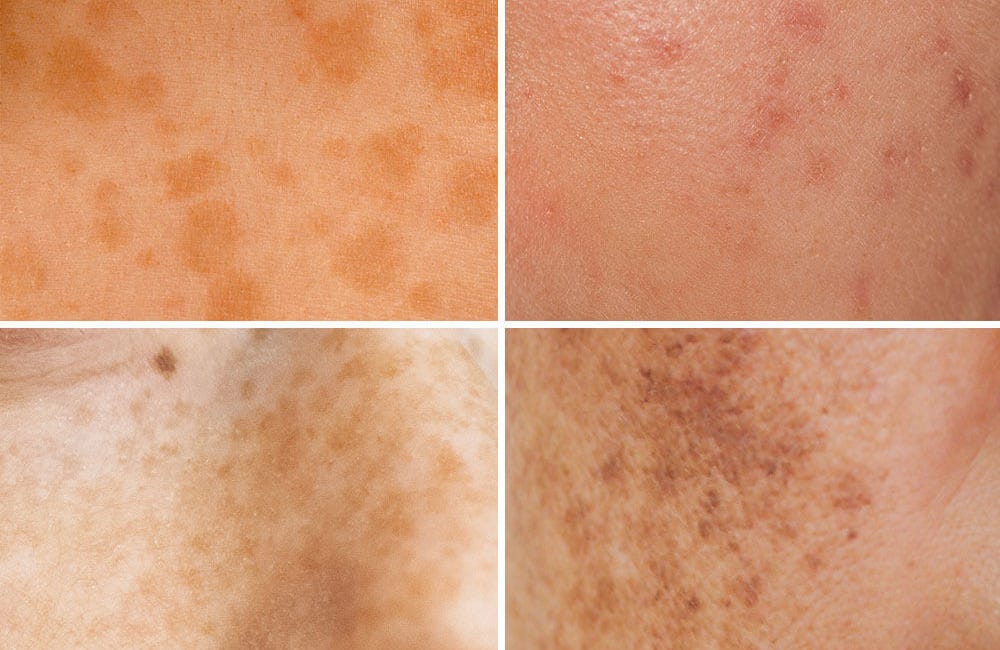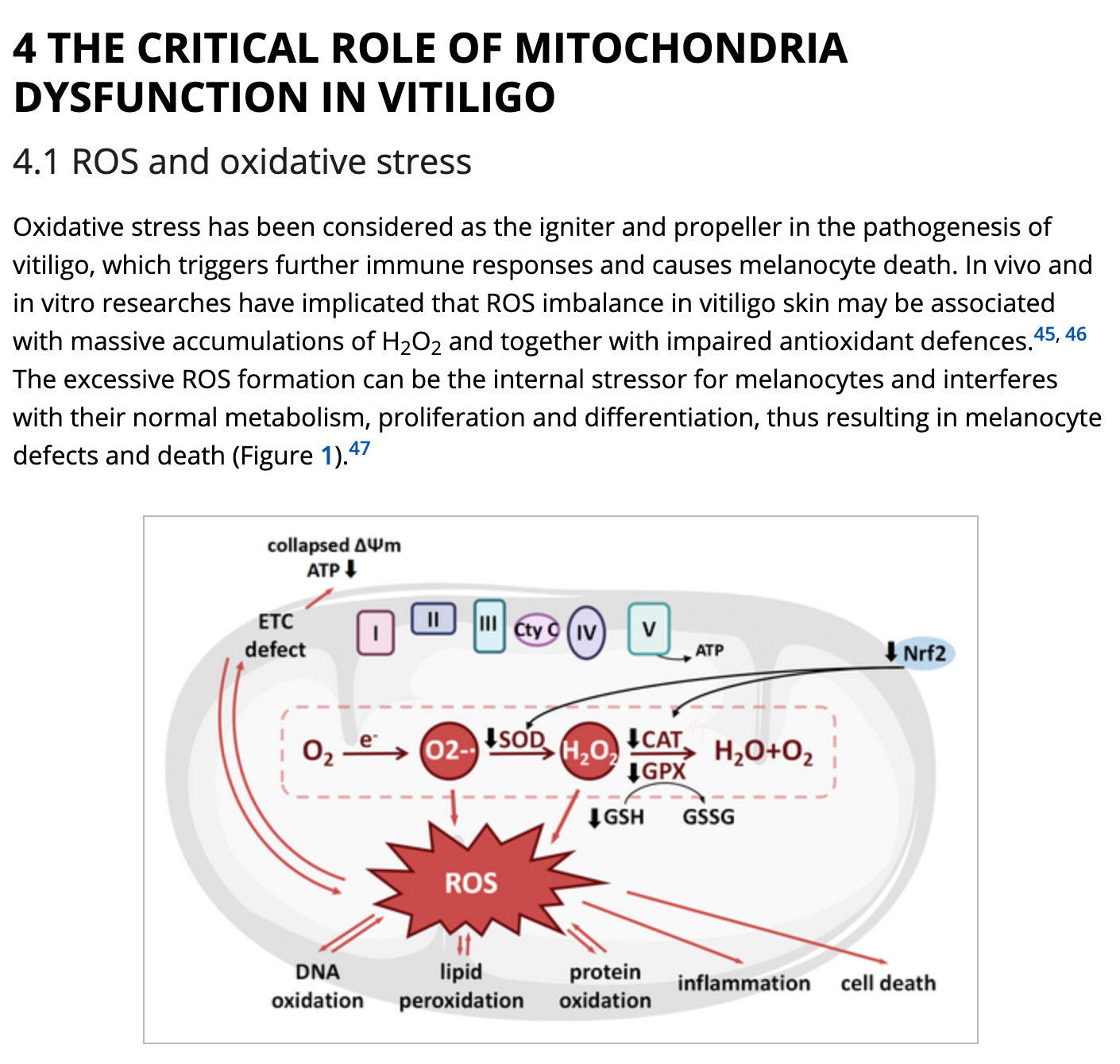Mitochondria: The Hidden Engine Behind Pigmentation
Yet another circadian truth your dermatologist doesn't know about
Mitochondria do more than produce energy.
They serve as critical regulators of skin pigmentation.
Melanogenesis, the complex cascade converting tyrosine into melanin, is energy intensive. Enzymes like tyrosinase, responsible for initiating the creation of melanin, and cellular processes such as melanosome formation and dendritic transport all require abundant ATP. Without sufficient mitochondrial energy, melanocytes struggle to synthesize and distribute pigment efficiently.
This is a large reason why I believe chronic skin conditions like hypo/hyperpigmentation, melasma, and vitiligo stem in large part from chronic mitochondrial dysfunction.
Hyperpigmentation & Melasma Through A Circadian Lens
I’ve had a number of people ask me questions about melasma specifically, and hyperpigmentation generally. This article will explore these skin manifestations through a circadian lens.
Mitochondria also generate controlled amounts of reactive oxygen species during oxidative phosphorylation. These ROS aren’t just byproducts, they act as signaling molecules. Appropriate ROS levels stimulate melanin production, activate antioxidant genes, and engage circadian feedback loops in the skin. Too little ROS leads to underactive pigmentation; too much causes oxidative damage and pigment irregularities.
UV Light as the Mitochondrial Trigger for Melanin
When melanocytes absorb UV light, mitochondria increase ATP and ROS production. This cascade activates the POMC → MSH (melanocyte-stimulating hormone) axis, which instructs melanogenesis as a hormetic defense mechanism and more. Melanin, therefore, isn't merely a pigment as I have mentioned a thousand times over. It's a mitochondrially-coordinated sunscreen.
Circadian Control of Pigmentation
Mitochondrial function, including their biogenesis and energy repurposing, follows circadian rhythms, peaking during daytime when sun exposure and UV is at its peak.
Accordingly, melanin production is also synchronized to daylight hours, optimizing protection and hormetic response when it’s most needed.
As I have mentioned before, tools like sunglasses interrupt this hormetic process entirely due to the fact that they block UV and the rest of the spectrum into the eyes which is a fundamental signal to the brain-skin axis for melanin production.
Furthermore, if you have an underlying pigmentation problem, then UV can excacerbate it. This isn’t because full spectrum sunlight is inherently the problem. It’s just magnifying a deeper circadian problem that stems from chronic lifestyle choices.
Centralized thinkers will tell you to avoid UV because of this, but they’re ignorant to the fact that it actually is a keystone solution within the framework of circadian alignment. We even have evidence of this through centralized research showing that narrowband UV light can fully REPIGMENT areas of the body for vitiligo patients.
As a tangent, isn’t it incredible how dermatologists demonize UV light from the full spectrum, yet their own research in the Journal of Dermatology shows the healing power of narrowband UV light on skin rejuvenation and pigmentation.
Mitochondrial-Melanosome Connections
As mentioned in the introduction of this article, research has revealed physical contacts between melanosomes and mitochondria, suggesting mitochondria directly influence melanosome biogenesis and redox environment. This underlines their central role in controlling pigment production and melanosome maturation.
Using 3D electron tomography, researchers discovered direct structural tethering between mitochondria and melanosomes via Mitofusin‑2 (Mfn2), akin to ER-mitochondria contact structures. This physical linkage supports melanosome maturation and pigment production.
This is all the evidence we need to understand that mitochondrial energy is a critical driver for melanin production at the sub-cellular level.
And since mitochondrial dynamics (fusion/fission, ATP bursts, ROS generation) are tightly regulated by the circadian clock, it is essential that you get into circadian alignment consistently over the long term.
Circadian disruption leaves the door wide open for pigmentation problems. When clock tuned mitochondrial function is misaligned through circadian disruption, the timing and efficiency of melanosome production falter. This is where we see uneven pigmentation, sunspots, melasma, and weakened UV protection manifest.
How much more evidence do you need that this is a more directionally accurate representation of the truth involved with not only these chronic skin manifestations, but how human circadian biology works at large?
Pigmentation is more than cosmetic, it reflects an energy driven, redox governed, time tuned biological system. Understanding mitochondria’s role not only deepens our basic science knowledge but also suggests novel targeting strategies, including those provided by God and Nature.
Melanosome-Mitochondria Coupling as a Circadian Feedback Loop
Consider positioning the physical coupling between mitochondria and melanosomes not just as a structural or energetic feature but as a circadian feedback loop.
Mitochondrial dynamics (fusion, fission, ATP output, ROS signaling) are under circadian clock control.
Melanin production is light responsive.
Together, this coupling likely acts as a biological timekeeper for the skin, aligning cellular defense with environmental light cycles.
Melanosome-mitochondria coupling likely act like a small internal clock (zeitgeber) for your skin, helping UV exposed areas stay in sync with the sun’s light-dark cycle.
It doesn’t end there either.
Melanin has a large protective role for mitochondria. Think of melanin as mitochondrial insurance, not just Nature’s most effective sunscreen.
UV triggers mitochondrial ROS → triggers melanin → melanin protects mitochondria from excessive UV → mitochondria maintain controlled ROS for signaling. This is a closed-loop feedback system of hormetic protection and adaptation.
So, there we have it.
We can easily frame pigmentation as a proxy for circadian resilience, where skin is the visible surface of deeper bioenergetic rhythms. It’s all there for the wise to see. The body doesn’t lie.
















And thus, the satisfaction of a suntan.